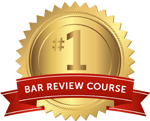The Multistate Bar Examination (MBE) was developed by the National Conference of Bar Examiners (NCBE), and it is one of the first milestones to becoming a licensed lawyer. To understand the exam’s scoring and instructions or to obtain sample outlines and questions, you can download the MBE information booklet from the NCBE website.
When studying for the MBE, think of it as a game. In other words, focus on playing rather than studying. Play the MBE every day with 34 questions at a time for as many weeks as possible before the exam. BarMax Prep makes this easy, as students get 1,750+ MBE questions from previous bar exams, licensed directly from the NCBE. Unlike other bar prep courses, BarMax provides real questions, which means you can rest assured the questions are written by the same minds that create the actual exam.
If you’re preparing for the MBE, this article covers all you need to know about how to ace the exam and pass with flying colors.
The MBE Structure
The MBE consists of two 3-hour (180 minutes) sessions made up of 100 questions each (200 questions in total). The first session takes place in the morning (9am – 12pm) and includes a one-hour break. The second session is in the afternoon (1pm – 4pm).
While practicing for the MBE, make a spreadsheet to track your progress and write down the number of questions you answer correctly (e.g. 10/34 = 29%). If you are using BarMax Prep, the app will track your progress for you.
The goal is to complete 17 questions in 30 minutes with 70% or better accuracy (i.e. – 24/34). Embrace your mistakes and learn from them while you prep, as opposed to making them on test day.
Start Early!
The earlier you start preparing for the MBE, the better. Remember, the bar is not like other tests: you need to know A LOT of information and be able to apply that knowledge in a timed setting.
Therefore, if you know you’ll be taking the bar, start preparing as soon as possible. Put together a study schedule. Set goals. Taking a prep course like BarMax is also a good idea as it can give you structure and provide a ton of study tools that will help you learn the material. The best way to think about the MBE is that you can never start preparing too early.
Study the Right Content
While it sounds like common sense, you need to study the right content. For example, the NCBE booklet outlines frequently tested issues for the seven tested subjects. These include:
- Civil Procedure
- Criminal Law and Procedure
- Contracts
- Constitutional Law
- Evidence
- Real Property
- Torts
Keep in mind the MBE is a national exam. This means you should ignore local laws and instead learn prevailing majority and minority views. Seven separate subject matter committees draft the MBE questions, so practice each subject separately.
Go Through Previous Bar Exam Questions
One of the best ways to ace the bar exam is to review questions from previous tests. As mentioned above, BarMax Prep comes with over 1,700 MBE questions from real exams, which is why a bar prep course is such a good idea. Like the LSAT, you’ll want to become familiar with the types of questions, the format, and how to answer them appropriately. BarMax Prep also includes explanations and notes for each MBE question.
Use Flashcards and Mnemonics
Anyone who has ever prepped for the bar exam (or taken the test) will know there is a ton of information to learn and memorize. Trying to absorb everything is tricky, especially as there are so many legal terms and laws to know. That’s where flashcards and mnemonics come in handy.
Mnemonics are devices for helping you memorize key rules and terms and can include things like acronyms, memorable phrases, or sayings. Flashcards, on the other hand, can include quizzes or practice questions that you must answer on the spot. Combining these two study methods can greatly improve your preparation for the MBE.
Practice Timing Yourself
The MBE is a timed exam, so you’ll need to be able to recall information quickly and learn how to adequately apportion time. Otherwise, you risk running out of time and not answering all the questions when you take the actual MBE.
Therefore, get in the habit of timing yourself answering a set of MBE questions, whether it’s answering 33 questions in an hour or 9 questions in 15 minutes. Start small and work your way up so that you’ll be confident you can answer 100 questions in 3 hours or less.
Most Important: Revise What You’ve Done
Along with the tips above, the MOST important part of practicing MBEs is not the number of questions you complete but rather studying the questions you have finished.
Zero-in on why you missed a question and understand the answer to every question. This will help you learn the law and catch patterns. Even if you get a question right, you should still review the answer to ensure you answered it correctly because you understood the question as opposed to random guessing. This approach will give you a look into the mind of the test makers.
Ask yourself:
- Why did I pick this answer?
- Why is the correct answer correct?
- Why are the incorrect answers incorrect?
- Do I know the law?
- Did I inappropriately assume facts?
- Did I read carefully?
Example MBE Question
To put this into practice, consider the example question below.
Plaintiff, a jockey, was seriously injured in a race when another jockey, Daring, cut too sharply in front of her without adequate clearance. The two horses collided, causing Plaintiff to fall to the ground, sustaining injury. The State Racetrack Commission ruled that, by cutting in too sharply, Daring committed a foul in violation of racetrack rules requiring adequate clearance for crossing lanes. Plaintiff has brought an action against Daring for damages in which one count is based on battery.
Will the Plaintiff prevail on the battery claim?
- Yes, if Daring was reckless in cutting across in front of Plaintiff’s horse.
- Yes, because the State Racetrack Commission determined that Daring committed a foul in violation of rules applicable to racing.
- No, unless Daring intended to cause impermissible contact between the two horses or apprehension of such contact by Plaintiff.
- No, because Plaintiff assumed the risk of accidental injury inherent in riding as a jockey in a horse race.
Most students can get this question down to choices (C) & (D).
Can you distinguish between the two? Why is one correct, and why is the other incorrect?
By getting into the habit of reviewing questions in this manner, you’ll become more adept at seeing the nuances of what’s being asked and why, rather than simply memorizing information.
Ace the MBE
Play the MBE as you would any other game. You will get addicted and have more fun studying for the bar exam, and this will help you maximize your score. By following the tips above, you can be well ahead and ready to ace the MBE exam. Good luck!




